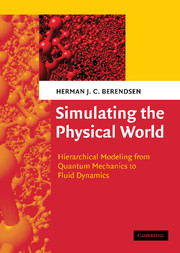Book contents
- Frontmatter
- Contents
- Preface
- Symbols, units and constants
- Part I A Modeling Hierarchy for Simulations
- 1 Introduction
- 2 Quantum mechanics: principles and relativistic effects
- 3 From quantum to classical mechanics: when and how
- 4 Quantum chemistry: solving the time-independent Schrödinger equation
- 5 Dynamics of mixed quantum/classical systems
- 6 Molecular dynamics
- 7 Free energy, entropy and potential of mean force
- 8 Stochastic dynamics: reducing degrees of freedom
- 9 Coarse graining from particles to fluid dynamics
- 10 Mesoscopic continuum dynamics
- 11 Dissipative particle dynamics
- Part II Physical and Theoretical Concepts
- References
- Index
9 - Coarse graining from particles to fluid dynamics
Published online by Cambridge University Press: 05 June 2012
- Frontmatter
- Contents
- Preface
- Symbols, units and constants
- Part I A Modeling Hierarchy for Simulations
- 1 Introduction
- 2 Quantum mechanics: principles and relativistic effects
- 3 From quantum to classical mechanics: when and how
- 4 Quantum chemistry: solving the time-independent Schrödinger equation
- 5 Dynamics of mixed quantum/classical systems
- 6 Molecular dynamics
- 7 Free energy, entropy and potential of mean force
- 8 Stochastic dynamics: reducing degrees of freedom
- 9 Coarse graining from particles to fluid dynamics
- 10 Mesoscopic continuum dynamics
- 11 Dissipative particle dynamics
- Part II Physical and Theoretical Concepts
- References
- Index
Summary
Introduction
In this chapter we shall set out to average a system of particles over space and obtain equations for the variables averaged over space. We consider a Hamiltonian system (although we shall allow for the presence of an external force, such as a gravitational force, that has its source outside the system), and – for simplicity – consider a single-component fluid with isotropic behavior. The latter condition is not essential, but allows us to simplify notations by saving on extra indexes and higher-order tensors that would cause unnecessary distraction from the main topic. The restriction to a single component is for simplicity also, and we shall later look at multicomponent systems.
By averaging over space we expect to arrive at the equations of fluid dynamics. These equations describe the motion of fluid elements and are based on the conservation of mass, momentum and energy. They do not describe any atomic details and assume that the fluid is in local equilibrium, so that an equation of state can be applied to relate local thermodynamic quantities as density, pressure and temperature. This presupposes that such thermodynamic quantities can be locally defined to begin with.
For systems that are locally homogeneous and have only very small gradients of thermodynamic parameters, averaging can be done over very large numbers of particles. For the limit of averaging over an infinite number of particles, thermodynamic quantities can be meaningfully defined and we expect the macroscopic equation to become exact.
- Type
- Chapter
- Information
- Simulating the Physical WorldHierarchical Modeling from Quantum Mechanics to Fluid Dynamics, pp. 279 - 296Publisher: Cambridge University PressPrint publication year: 2007



